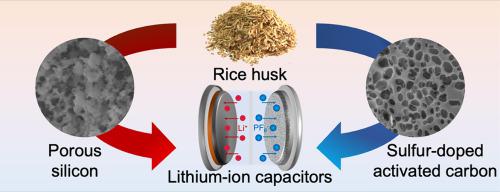当前位置:
X-MOL 学术
›
Sustain. Mater. Technol.
›
论文详情
Our official English website, www.x-mol.net, welcomes your feedback! (Note: you will need to create a separate account there.)
The total use of rice husk to create highly porous silicon and sulfur-doped activated carbon for the fabrication of high-performance silicon-anode lithium-ion capacitors
Sustainable Materials and Technologies ( IF 9.6 ) Pub Date : 2024-03-26 , DOI: 10.1016/j.susmat.2024.e00914 Thanapat Jorn-am , Xiao Liang , Shufeng Song , Chalathorn Chanthad , Peerasak Paoprasert
Sustainable Materials and Technologies ( IF 9.6 ) Pub Date : 2024-03-26 , DOI: 10.1016/j.susmat.2024.e00914 Thanapat Jorn-am , Xiao Liang , Shufeng Song , Chalathorn Chanthad , Peerasak Paoprasert

|
The promising advantages between the high energy density of lithium-ion batteries and the high power density of supercapacitors are hybridized to construct lithium-ion capacitors (LICs). The high capacity of anode materials is challenging for high-performance LICs. Simultaneously, the quest for sustainable and environmentally friendly energy storage materials has attracted attention. In this work, rice husk was treated with alkaline to separate silica and biochar, followed by magnesiothermic reduction and thermal activation to produce porous silicon (PSi) and sulfur-doped activated carbon (SAC), respectively. The PSi had high porosity for accommodating volumetric expansion during cycling, resulting in outstanding rate capability and cycling stability, whereas the SAC had a high surface area with micro- and mesopores (2511 m g), a high degree of graphitization, and excellent electrochemical performance. For the fabrication of half-cell lithium-ion batteries, PSi gave a specific capacity of 1005.3 mAh g between 0.01 and 2 , while SAC provided a specific capacity of 108 mAh g (2.0–4.5 V), and showed a better electrochemical stability than the both commercial silicon and activated carbon. When a full-cell LIC was fabricated, the optimized P-Si//SAC LIC had a high energy density of 107 Wh kg at a power density of 163 W kg and a capacitance retention of 81.3 and 61.8% between a potential range of 2.0–4.5 after 1000 and 3000 charge-discharge cycles, respectively. This study not only turned agricultural waste into valuable, high-performance LICs but also made significant progress toward the creation of environmentally responsible, long-lasting, and sustainable energy storage systems.
中文翻译:

完全利用稻壳制造高孔隙硅和掺硫活性炭,用于制造高性能硅阳极锂离子电容器
锂离子电池的高能量密度和超级电容器的高功率密度之间的优势被混合起来构建锂离子电容器(LIC)。负极材料的高容量对于高性能LIC来说是一个挑战。与此同时,对可持续且环保的储能材料的探索引起了人们的关注。在这项工作中,用碱处理稻壳以分离二氧化硅和生物炭,然后通过镁热还原和热活化分别生产多孔硅(PSi)和硫掺杂活性炭(SAC)。 PSi具有高孔隙率,可适应循环过程中的体积膨胀,从而具有出色的倍率性能和循环稳定性,而SAC具有高表面积、微孔和中孔(2511 m g)、高度石墨化和优异的电化学性能。对于半电池锂离子电池的制造,PSi 在 0.01 至 2 之间的比容量为 1005.3 mAh g,而 SAC 的比容量为 108 mAh g(2.0-4.5 V),并且表现出比 SAC 更好的电化学稳定性。商业硅和活性炭。当制造全电池 LIC 时,优化的 P-Si//SAC LIC 在功率密度为 163 W kg 时具有 107 Wh kg 的高能量密度,在 2.0 电位范围内的电容保持率为 81.3% 和 61.8%。分别在 1000 次和 3000 次充放电循环后为 –4.5。这项研究不仅将农业废物转化为有价值的高性能LIC,而且在创建对环境负责、持久和可持续的能源存储系统方面取得了重大进展。
更新日期:2024-03-26
中文翻译:

完全利用稻壳制造高孔隙硅和掺硫活性炭,用于制造高性能硅阳极锂离子电容器
锂离子电池的高能量密度和超级电容器的高功率密度之间的优势被混合起来构建锂离子电容器(LIC)。负极材料的高容量对于高性能LIC来说是一个挑战。与此同时,对可持续且环保的储能材料的探索引起了人们的关注。在这项工作中,用碱处理稻壳以分离二氧化硅和生物炭,然后通过镁热还原和热活化分别生产多孔硅(PSi)和硫掺杂活性炭(SAC)。 PSi具有高孔隙率,可适应循环过程中的体积膨胀,从而具有出色的倍率性能和循环稳定性,而SAC具有高表面积、微孔和中孔(2511 m g)、高度石墨化和优异的电化学性能。对于半电池锂离子电池的制造,PSi 在 0.01 至 2 之间的比容量为 1005.3 mAh g,而 SAC 的比容量为 108 mAh g(2.0-4.5 V),并且表现出比 SAC 更好的电化学稳定性。商业硅和活性炭。当制造全电池 LIC 时,优化的 P-Si//SAC LIC 在功率密度为 163 W kg 时具有 107 Wh kg 的高能量密度,在 2.0 电位范围内的电容保持率为 81.3% 和 61.8%。分别在 1000 次和 3000 次充放电循环后为 –4.5。这项研究不仅将农业废物转化为有价值的高性能LIC,而且在创建对环境负责、持久和可持续的能源存储系统方面取得了重大进展。

































 京公网安备 11010802027423号
京公网安备 11010802027423号